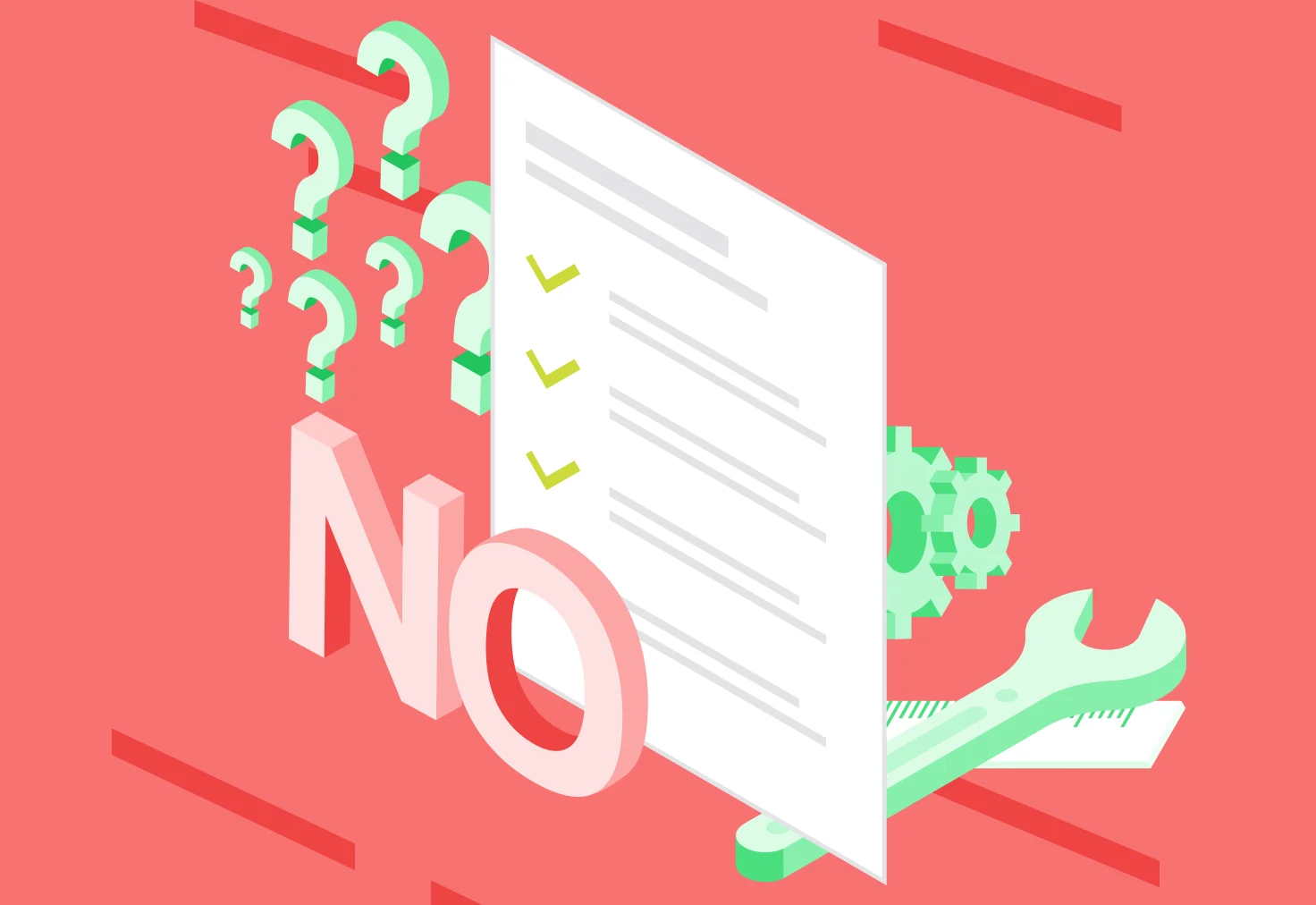If you’re sending your curriculum vitae to multiple companies but are constantly rejected or you’re never hearing back, chances are that you’re making some CV mistakes.
As is the case with a resume, crafting a strong curriculum vitae can be tricky. One or two spelling mistakes here and there, formatting that is a bit off, or an unprofessional email address can all lead to instant rejection.
To help you avoid any errors that can cost you a job, we’ve compiled a list of CV mistakes you should avoid no matter what. Dig in!
Key Takeaways
Common or funny CV mistakes could be one of the reasons why hiring professionals keep rejecting your job application.
Outside the USA and Canada, a CV and resume are interchangeable; in these two countries, a CV is more detailed than a resume and is submitted for jobs in academia.
Using the wrong format, not proofreading your CV for spelling and grammatical errors, not tailoring your CV to a role, and using cliches are just some of the most common CV mistakes.
Many candidates also tend to lie and exaggerate in their CVs, mention salary requirements, ignore employment gaps, and add too much personal information.
CV vs. Resume: What Is the Difference?

The difference between a CV and a resume depends on your state of residence. If you live outside the US or Canada, both refer to a document you submit to a potential employer and can be used interchangeably.
In the United States and Canada, however, a resume stands for an account of work experience, accomplishments, and skills. Whatever job you’re applying for, you’re supposed to submit a resume accompanied by a cover letter.
A CV refers to a document you send when you’re seeking a job in academia or for positions like a curriculum developer resume. It outlines your scholarly career, including your education, publications, conferences, presentations, and similar achievements. As such, it is much longer and more detailed than a resume, sometimes even going up to ten pages.
18 Common CV Mistakes You Shouldn’t Make
Here’s a list of the most common CV mistakes you should never make:
#1. Not Having the Right Format
Poor CV formatting often results in rejection. If a recruiter can’t discover all the information they are interested in in up to ten seconds, they will throw your CV away and move on to the next one.
Thus, it’s critical that you let them find the information they want right away. The best way to achieve this is by using an adequate CV format that will make the most important information visible at first glance.
#2. Having Spelling and Grammar Errors
Submitting a curriculum vitae that has spelling and grammar errors is possibly one of the worst mistakes you can make. It doesn’t only look bad; it also hints that you’re sloppy, careless, and a bad communicator who is not interested enough in the position.
Such an employee is unwanted in a company, so most of the recruiters—even 61% of them—will reject you straightaway.
Before you send your application, double-check and proofread your CV to make sure that there are no typos or any other mistakes. You can use tools such as Grammarly or QuillBot or ask your family or friends to proofread it for you.
#3. Too Short/Too Long CV
Adding your professional history to your CV can be tricky if you have lots of or no experience whatsoever. Both may result in a curriculum vitae that is either overly long or short. Though it is your professional biography, a CV is not an autobiography; as such, it shouldn’t include every single detail of your (professional) life.
The ideal length of a CV is one to two pages. Resist the urge to list all your work experience, achievements, and skills and add only those that are relevant to the position to keep your curriculum vitae to one page.
#4. Using Cliches
Are you a detail-oriented, hard-working, and highly skilled marketing guru with SEO ninja-like skills? Are you also a critical thinker and an excellent team player with strong communication skills? If you are, good for you—but can you support this with measurable achievements?
The problem with the abovementioned phrases is that they are so overused that they have become cliches. Every single job seeker is a great communicator, team player, decision-maker, fast learner, or self-starter. In reality, these phrases mean nothing if you can’t prove them.
Instead of just listing those buzzwords, use metrics whenever possible. You’ll not only get rid of cliches, but you’ll also give your CV more credibility.
#5. Not Tailoring Your CV to a Specific Role
Whenever you apply for a job, you should tailor your CV specifically to it. This implies including relevant skills, experiences, and achievements to suit the company's requirements. It may take more time to write a CV, but it will certainly produce better results—an invitation for an interview.
A generic, one-size-fits-all curriculum vitae could be easier to craft and send out to any job ad that seems attractive. Yet, such CVs are a one-way ticket to rejection, as 63% of recruiters prefer candidates who make an effort to tailor their curriculum vitae.
#6. Adding Incorrect Contact Information
In addition to giving an account of your professional history and skills, a CV should allow a hiring professional to get in touch with you. But how are they supposed to do so if you list the wrong email address or phone number and they reach out to somebody else?
Worse than sending a CV with spelling mistakes is submitting one with incorrect contact information and hindering a recruiter from contacting you. Thus, when proofreading your curriculum vitae, check this section as well and ensure that you’ve listed:
Mandatory Information
(Correct) first and last name
(Correct) job title
(Correct) email address and phone number
Location
#7. Not Emphasizing Your Achievements
Your professional experience should let a recruiter see whether you possess the skills and expertise they are looking for in a candidate. However, if you fail to list your previous achievements but add only your duties or responsibilities, you won’t reveal the information they’re looking for.
Quantifiable achievements, i.e., those that include specific figures and percentages, give insight into your performance and the impact you had in your previous company. This will further make recruiters aware of the contribution you can make to their company and urge them to schedule an interview with you.
#8. Including References

A while ago, references were a mandatory part of a CV. Even though it’s not the case anymore, there are candidates who still include them, hoping to make their curriculum vitae more reliable or credible.
Unless it’s specified in a job ad, you should refrain from adding references to your CV. If you do list them despite the absence of instructions, it may be perceived as your refusal or failure to follow clear instructions.
#9. Using an Inappropriate Email Address
Suppose that you received a job offer from a recruiter or headhunter whose email goes like markthetalenthunter@gmail.com, how would you react? Chances are that you would consider it a joke or a scam and just ignore it. The same applies to a hiring professional who receives a CV from a candidate with an unprofessional email.
When you’re submitting a job application letter, always use a professional-looking email address consisting of your first and last name. Keep the funny one for your family and friends.
Here’s an example of a presentable email:
Presentable Email Example
#10. Not Proofreading
Imagine the following scenario: you’ve just sent an application for a fantastic job you’ve always wanted, only to realize that you’ve forgotten to include your contact information in your curriculum vitae. To avoid such dreadful mistakes, it’s critical to proofread your CV.
Proofreading is not always about checking for typos. You do it to check if you have any incoherent sections, bad sentence structure, or punctuation errors or see if you’ve included all the important information regarding your qualifications, experience, and education.
#11. Exaggerating or Lying
Lying in your CV is not as infrequent as you may think—as many as 70% of candidates have “embellished the truth” when applying for a job, 37% of whom do so on a regular basis. Yet, though many people tend to do so, it doesn’t mean it’s acceptable.
Misrepresenting yourself in a curriculum vitae is regarded as fraud and may have serious consequences. You may be rejected or earn a bad reputation; in the worst-case scenario, legal action could be taken against you.
#12. Not Adding Your Interests/Hobbies
You may think that your hobbies or interests don’t belong in a curriculum vitae, but you are wrong. Though it’s not mandatory to include it in a CV, adding this section may be quite beneficial.
If your hobbies and interests align with the position you want to apply for, it can indicate that you’re indeed passionate about the role. Plus, you have a chance to develop a bond with a hiring professional and have a topic for discussion during an interview.
#13. Ignoring Employment Gaps
It’s not a huge deal if you have an employment gap in your CV; what is a big deal, however, is if you don’t elaborate on it. In such a case, a recruiter may think that you were dismissed because of mistakes, contract breaches, etc.
Thus, if you’ve had a gap in your career, explain what forced you to take a break from work. Otherwise, you may be considered an untrustworthy employee and be rejected.
Here’s how you can put it:
Employment Gap Explanation Example
September 2021–September 2022
Took a sabbatical to complete master’s studies
#14. Writing Salary Requirements
There’s nothing wrong with negotiating a salary; yet, a curriculum vitae isn’t quite a good place for that. This should be discussed a bit later, during an interview.
Though this may sound like one of the most unusual CV mistakes no one would ever make, there are candidates who still do it.
If you mention your salary expectations or requirements in your CV, you may give the impression that you’re interested in the company or position only because of money. As a result, you’ll be turned down instantly, even if your qualifications and experience fit the company perfectly.
#15. Having Big Chunks of Text
A solid CV should be divided into sections to allow a recruiter to instantly spot the information they are looking for. Furthermore, for better coherence and clarity, bulleted points should also be included.
Failing to add sections or bullet lists will result in huge chunks of text that a recruiter will find difficult to follow, let alone spot the information they are interested in. Consequently, they will discard your application and move on to another candidate.
#16. Including Your Photo
Although it was mandatory only a few years ago, adding a headshot to your CV is now frowned upon. There are two reasons behind that.
Firstly, a curriculum vitae with a photo included will not pass the ATS pre-screening as the software doesn’t recognize pictures. Hence, your otherwise spotless CV may remain unnoticed by the human eye just because of a simple headshot.
Secondly, a photograph can open the door to discrimination against gender, race, or age. To prevent this, some countries have banned adding photos to a curriculum vitae or resume.
#17. Listing Personal Information.
A curriculum vitae should list your full name, email address, phone number, and location; anything other than that is unnecessary.
What you should never include in a curriculum vitae is:
Personal Information Not to Include
Physical address (state and city will be enough)
Religion
Sexual orientation
Political views
Marital status
Number of children
These pieces of information are completely irrelevant to your job application. Plus, upon seeing them, a hiring professional may pander to subconscious prejudice and choose another candidate.
#18. Using the Incorrect CV Template
CV templates may come in quite handy when you’re crafting your curriculum vitae. You can use a template to help you come up with ideas and design your CV from scratch, or you can simply fill it out with the necessary information and customize it to your liking.
However, not all CV templates are the same. Many of them may contain distracting graphics or require unnecessary information while at the same time missing out on the essential ones.If you’re not sure what to choose, check out the CV templates at Resume.co.
Our templates are not only visually appealing and easy to follow; they are also ATS-friendly and will pass pre-screening processes without hassle.
Final Thoughts
CV mistakes could be one of the reasons why your job applications are constantly turned down or ignored. Creating a solid curriculum vitae is challenging, so it doesn’t come as a surprise that job seekers frequently make CV mistakes without even being aware of them.
We hope that our comprehensive guide will help you avoid committing CV errors so that you can craft a stellar curriculum vitae and land an interview!
Related Articles
How to Write a CV Personal Statement [20 Examples Included]


